
Fundamentals of Robot Operating System (ROS)
Robot Operating System (ROS) is an open-source framework that has become the de facto standard for robotics software development. Modern […]
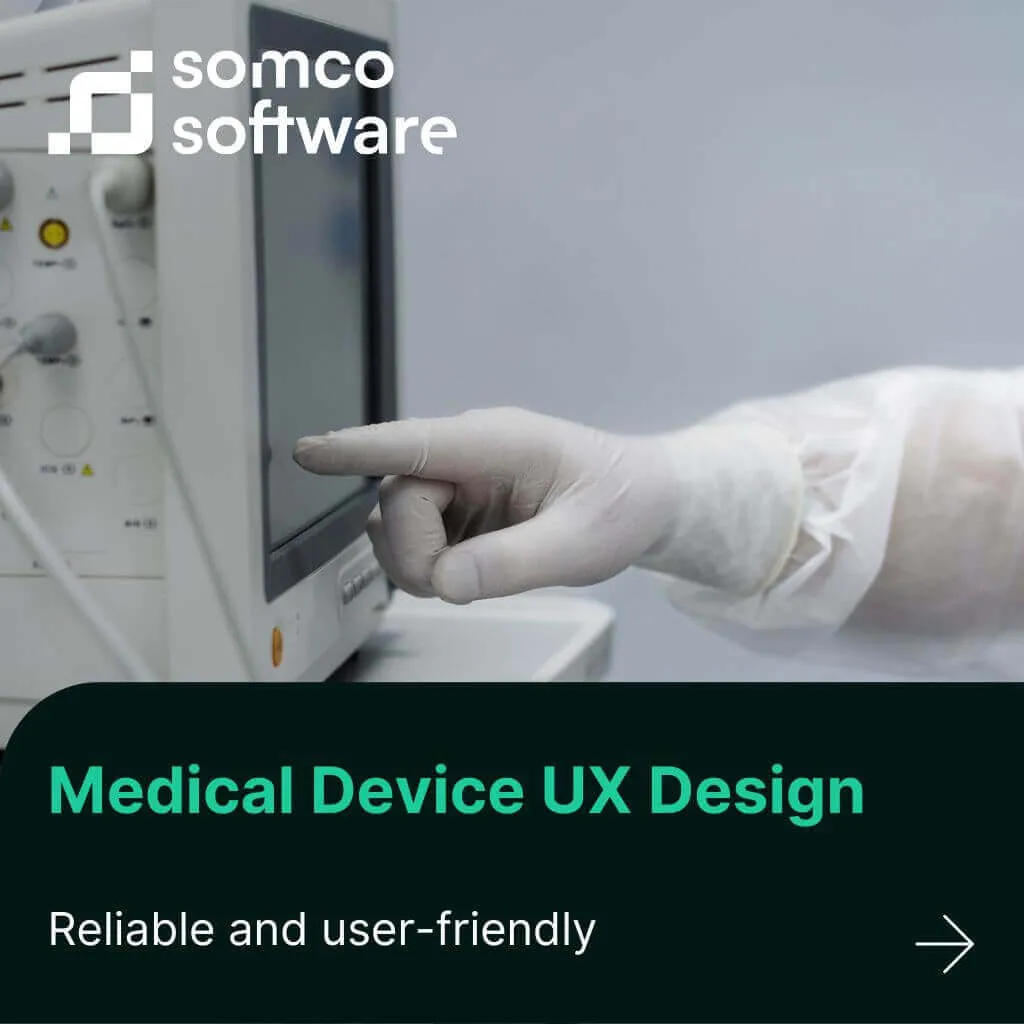
While user experience (UX) principles are well established in consumer software, applying them to medical devices is different: regulatory requirements, safety-critical environments, diverse user populations, life-threatening consequences of design failures that demand specialized approaches for medical device industry and MedTech industry, requires close collaboration between UX designers and clinicians.
Understanding how to implement UX design for medical devices and navigate regulatory compliance is key for any organization developing healthcare technology, diagnostic equipment or therapeutic solutions within the broader healthcare industry.
This guide will help you:
Need help with your medical device development project? Let’s talk!
Medical device UX design refers to the systematic approach of creating user interface design and experiences for medical technology products that prioritize usability, safety, and effectiveness. This discipline encompasses everything from diagnostic equipment and surgical instruments to patient monitoring systems and therapeutic devices. The primary goal is to create interfaces that minimize user errors, prevent medical errors, enhance workflow efficiency, and ultimately improve patient outcomes through rigorous human centered design principles.
Unlike consumer product design, medical device UX must balance user friendly interfaces with regulatory requirements and safety-critical applications. The building medical devices process must account for high stress environments, diverse user populations (from medical professionals to patients) and life-threatening consequences from user errors.

Medical device UX is different from consumer electronics UX. In consumer tech speed to market and innovation rules: minor bugs or design inconsistencies can be patched post launch. Users will tolerate occasional flaws to get the latest features. But healthcare can’t operate that way. Testing, risk management and validation are prioritised over agility. Teams on medical projects are cautious and analytical, aiming for stability, predictability and safety first.
| Aspect | Consumer UX | Medical UX |
| Priority | Speed to market, innovation | Safety, compliance, stability |
| Tolerance for bugs | High (patches possible) | Near-zero (life-critical) |
| Iteration | Rapid, post-launch updates | Slow, must be validated & re-certified |
| Users | Mostly homogeneous, tech-savvy | Diverse: surgeons, nurses, elderly patients, caregivers |
| Context | Casual, personal use | High-stress, sterile, time-critical environments |
Unlike typical UI design in consumer products, medical device UX requires stricter validation to protect patients and healthcare professionals.
A key part of modern medical devices is the software and the user interface. In many cases the software drives the device and the effectiveness of the product relies heavily on the quality of the UI and the screen the user interacts with. So medical UX is not just about workflows and interaction patterns but also about making sure the interfaces are optimized for the specific screens used in clinical environments. In practice this means bridging software prototypes with dedicated hardware which requires close collaboration between software teams and partners who provide professional, medical grade display solutions.
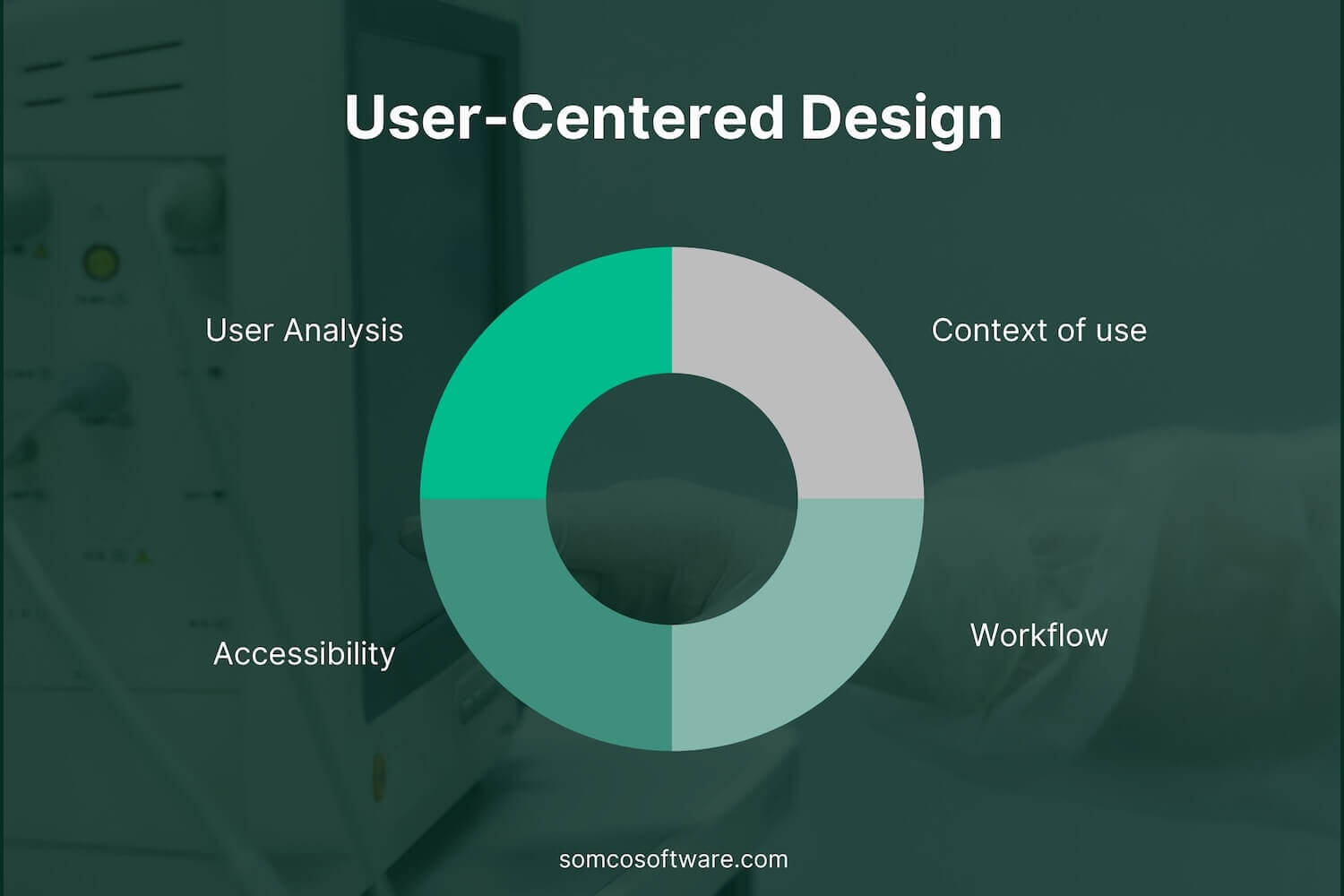
Medical device UX is based on user-centered design (UCD). This methodology puts the intended users, their contexts and their workflows at the centre of the development process. This typically includes:
In operating room environments accessibility takes on additional layers of complexity. Medical grade screens are often covered with protective films which can alter color perception and reduce clarity. Surgeons and staff operate with double gloves which reduces tactile precision when interacting with touchscreens. And on top of that the lighting conditions can vary drastically – sometimes the room is intentionally dim, sometimes strong surgical lights create extreme brightness. These realities make contrast, color choices and touch sensitivity critical design factors. Effective UX in such environments requires testing on actual clinical displays to ensure legibility, responsiveness and safety under real world constraints.
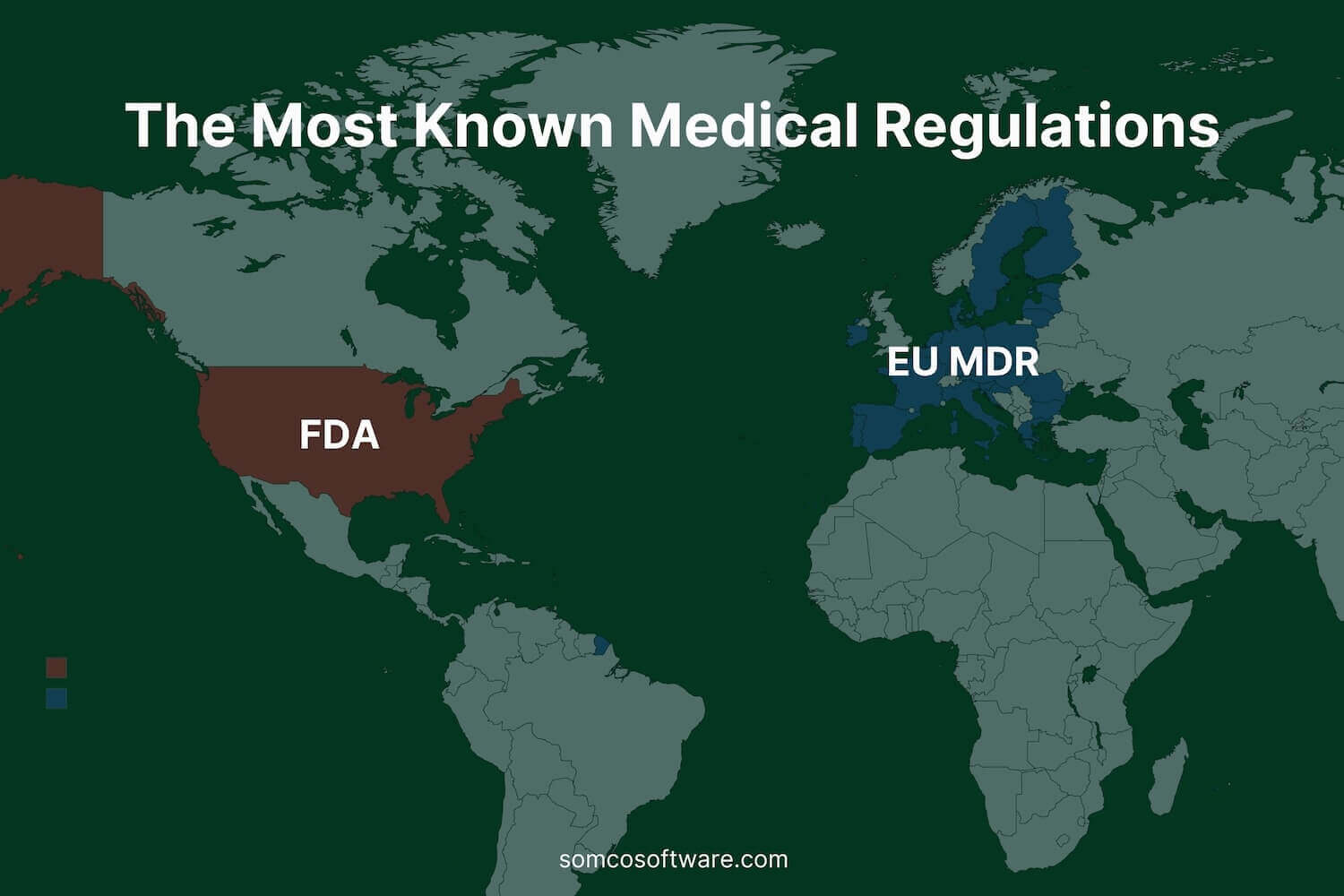
Medical device UX design operates within strict regulatory frameworks that require specific usability engineering processes:
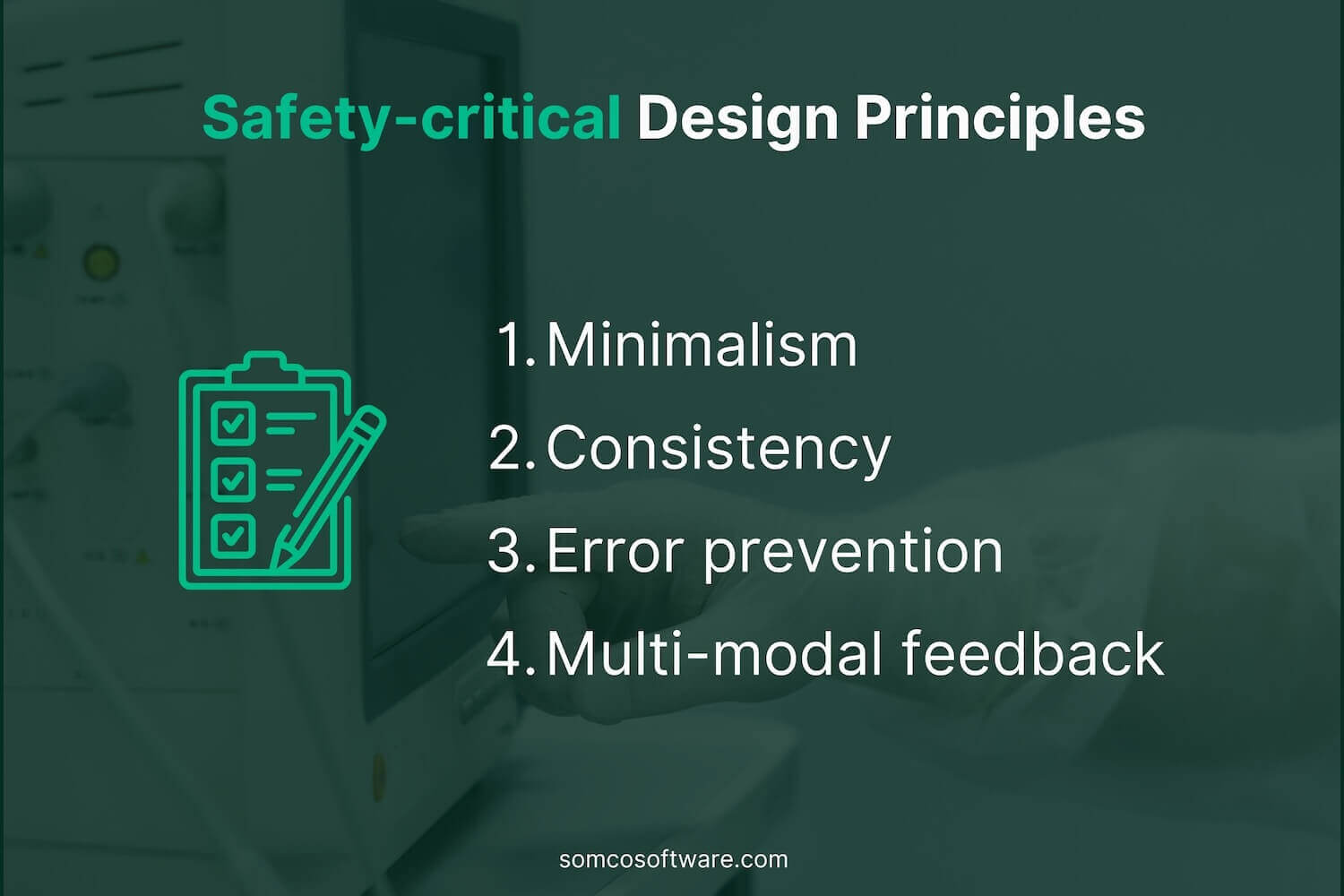
Every medical software project starts with understanding the people who will ultimately use it. In healthcare this goes beyond simple questionnaires or demographic data — it requires immersing oneself in the clinical environment to capture the reality of workflows, constraints and decision-making under pressure.
One of the most valuable methods is ethnographic research. By observing physicians, nurses and technicians in their natural work environments designers can uncover how devices are truly used, not just how they were intended to be used. For example a nurse working under time pressure in an intensive care unit may use shortcuts or workarounds that expose hidden usability risks. Documenting these behaviors early provides critical input for safer, more intuitive design.
Alongside observation stakeholder interviews bring forward the voices of different user groups. Primary users such as clinicians may emphasize precision and reliability, secondary users like maintenance staff may focus on ease of calibration and patients may care most about comfort or clarity of instructions. Gathering these perspectives creates a more complete picture of real-world needs helping to avoid designs that serve one group at the expense of another. Finally competitive analysis plays a key role. By studying existing devices — both successful and recalled — teams can identify industry best practices, recognize patterns of user erro,r and spot opportunities for differentiation. Competitor benchmarks not only inform design choices but also provide valuable evidence for regulators demonstrating that usability risks have been addressed systematically.
Once insights are gathered the challenge becomes turning them into concrete, testable concepts. This is where ux for medical prototyping bridges research with real-world experimentation.
It typically starts with wireframes and low-fidelity mockups. These simple sketches or digital outlines help map out the structure of screens, menus and interaction flows. Their low level of detail is intentional: by stripping away distractions like color or branding teams can focus discussions on whether the information architecture makes sense. Rapid iteration at this stage allows multiple concepts to be explored without heavy investment.
From there teams move into interactive prototyping. Clickable prototypes or functional simulations allow users, including clinicians and UX designers, to experience how a device might behave long before final development. This early hands-on experience is invaluable: users can point out confusing layouts, inefficient navigation or unclear labeling and stakeholders can provide feedback that shapes design direction before expensive engineering resources are committed.
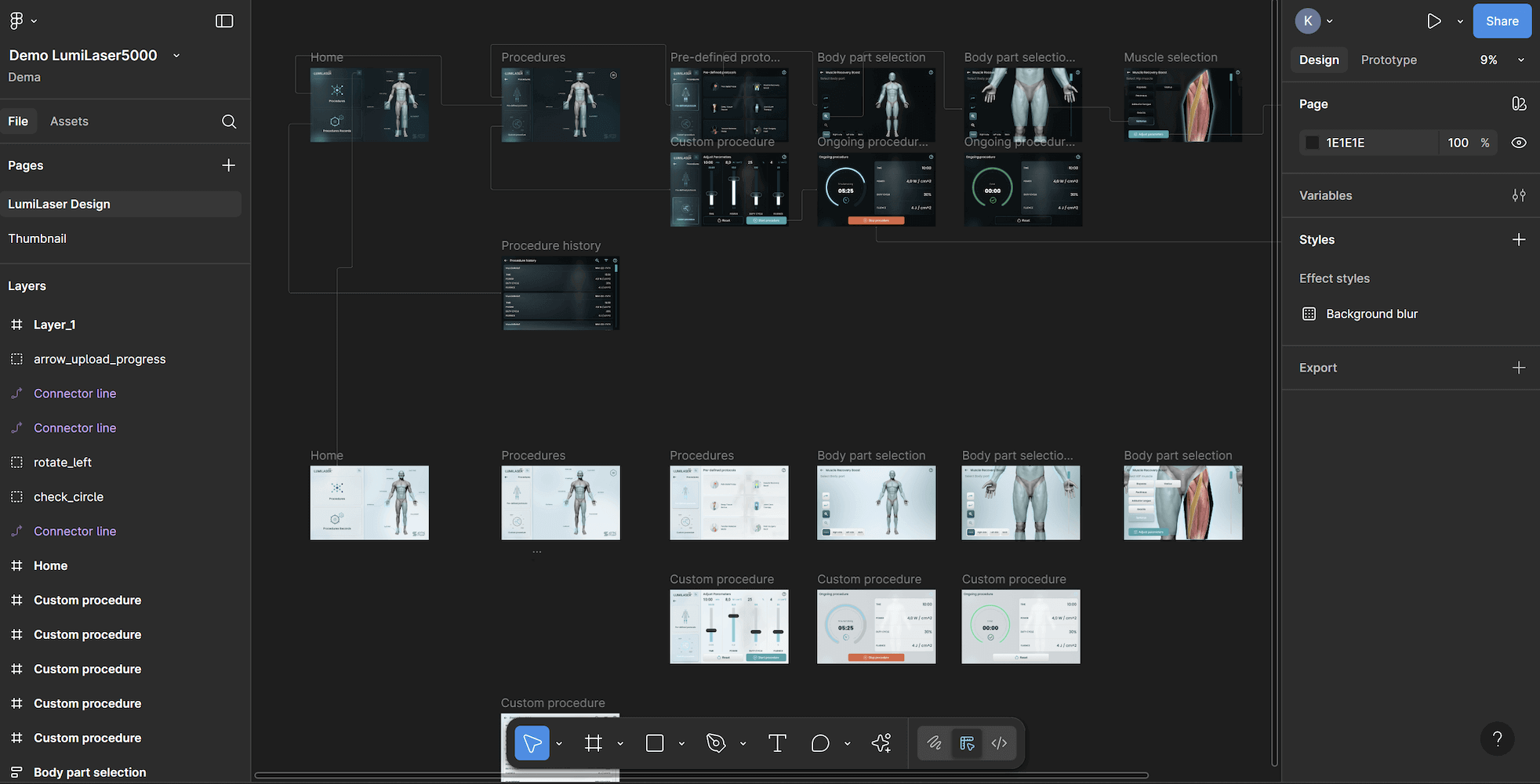
At this stage it’s also important to make sure prototypes are not developed in isolation from the hardware they will run on. Medical device interfaces are often displayed on specialized, medical grade screens that are very different from consumer screens.
Przemysław Sowa – CTO at Somco Software:
“Our approach is to work closely with hardware partners to integrate prototypes with these dedicated displays early on. This collaboration allows team to validate not only interaction flows but also how colors, contrast and responsiveness behave on real equipment used in clinical environments.”
As embedded software company specialized in developing medical devices, we also consult our customers on things such important for how the device is perceived as displays. We partner with right technology providers to make sure apps we design and implement will look good in dark operation room.
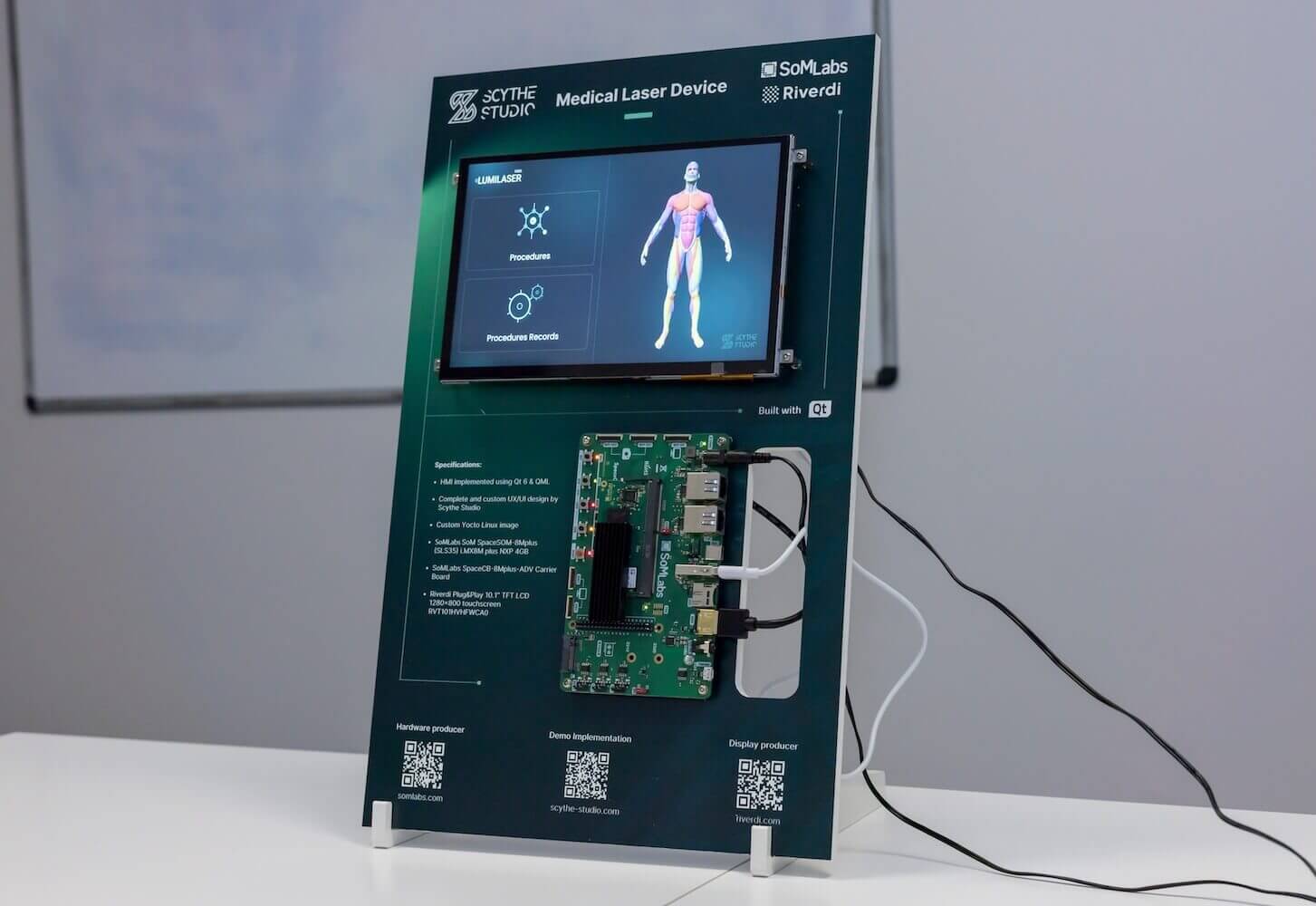
By aligning software prototyping with professional display technology potential usability risks can be identified and resolved before costly engineering and regulatory steps begin.
Only after functionality is validated does visual design come into play. In the medical context visual treatment is not just about aesthetics — it is about safety. Color palettes must communicate urgency and status consistently (e.g. red for critical alarms, green for safe states). Iconography must be instantly recognizable even under stress. Layouts need to remain clear and legible on different display types whether in a dimly lit operating room or on a portable bedside device. A carefully considered visual layer ties the interface together and supports the cognitive workload of healthcare professionals.
In consumer software usability testing may be the last step before launch. In the development process of medical technology it is a regulatory requirement — a structured pathway that generates evidence of safety and effectiveness.
The process typically starts with formative testing. These iterative studies are conducted throughout the design cycle allowing teams to experiment with alternatives, observe user interactions and refine concepts. The goal here is learning — uncovering unexpected use behaviors and eliminating potential sources of error before the design becomes locked down.Next summative validation, a far more formal process. Carried out under conditions that closely simulate real clinical use, summative studies are designed to demonstrate to regulators such as the FDA or notified bodies in the EU that the device can be used safely and effectively by its intended users, without unreasonable risk. Unlike formative testing this stage is not about exploration — it is about proof.
Finally rigorous metrics and analysis give these studies their weight. Standardized measures such as task completion rates, time on task, error frequency and user satisfaction scores provide objective data that supports regulatory submissions. Beyond compliance these metrics also help manufacturers quantify the business value of UX: reduced training costs, faster adoption by clinicians and fewer post-market complaints.
Usability engineering activities must be embedded in the organization’s Quality Management System (QMS) typically aligned with ISO 13485. This ensures traceability of usability requirements, test results and risk controls throughout the product lifecycle. Artifacts such as the Usability Engineering File, usability risk analyses and validation reports should be part of the Design History File (DHF) and linked to the risk management file under ISO 14971. Embedding usability into the QMS not only streamlines regulatory audits but also fosters a culture of safety and continuous improvement.
As technology advances UX design in healthcare is evolving rapidly:
Despite best intentions, many manufacturers encounter the same issues:
| Problem | Description | Solution |
|---|---|---|
| Information Overload | Packing too much data onto a single screen. | Progressive disclosure and intelligent filtering. |
| Workflow Disruption | Designing interfaces that force clinicians to change established practices. | Study workflows deeply and design around them. |
| Inconsistent Design Patterns | Lack of standardization across devices increases training time and error rates. | Create a design system with shared patterns. |
| Underestimating Documentation Needs | Regulatory submissions require extensive usability documentation. | Integrate documentation into every stage of design, not as an afterthought. |
The EU MDR and FDA’s post-market surveillance requirements make it clear that usability doesn’t stop at launch. Manufacturers must collect and analyze real-world feedback, including complaint data, adverse event reports and feedback from field service teams. This information should feed into Corrective and Preventive Actions (CAPA) and continuous improvement processes. Post-market usability monitoring helps detect emerging risks, validates training is still adequate and ensures devices remain safe and effective throughout their lifecycle.
Our team offers medical device software development with integrated UX design:
Need help with your project? Let’s talk!
Medical device UX design is a complex discipline that requires balancing user needs, technical constraints and regulatory requirements. Success in this field means understanding healthcare workflows, applying user-centered design principles systematically and validating design decisions through thorough testing. As medical technology advances UX design will play an even more important role in making these powerful tools a help not a hindrance to healthcare.
Let's face it? It is a challenge to get top Qt QML developers on board. Help yourself and start the collaboration with Somco Software - real experts in Qt C++ framework.
Discover our capabilities
Robot Operating System (ROS) is an open-source framework that has become the de facto standard for robotics software development. Modern […]

“21 August 2025 –What a night! Somco Software organized a Qt C++ Warsaw meetup and [dot, dot, dot]”* —– *-This […]

Software as a Medical Device (SaMD) refers to software that is intended for medical purposes (such as diagnosing, treating, curing, […]